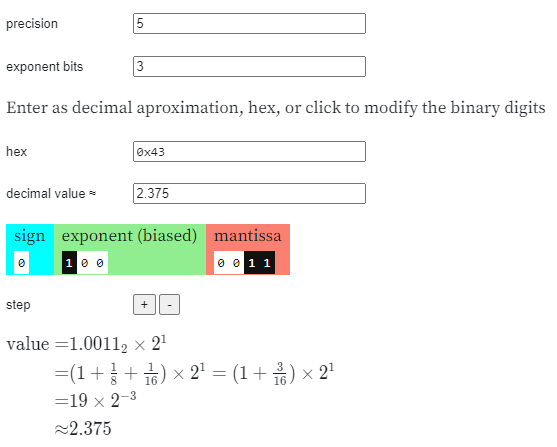Topic 1d
Floating-point Representation
Prior to Class
By the end of this topic students should be able to:
- Explain how a computer stores decimal numbers in the floating-point format using [8 | 32] bits.
Assigned Reading
- Floating point representation - pp 63-66
- NOTE: There is an error on page 65. The second line of text should read "the value represented would have been - 2 3/4" That is, it should be a NEGATIVE number.
In class
Discussion
Let's walk through this idea for a bit.
Checking for Understanding
We are mostly concerned about the following:
- Can you explain how floating point values are stored in the computer standard of 32 bits
- For each of the following terms, what does it represent, and how much of the 32 bits is allocated to this portion
- Mantissa (What does it represent? How much memory?)
- Exponent Field (What does it represent? How much memory?)
- Sign Bit
- Can you explain how floating point values are stored in the textbook example of only 8 bits
While we would not ask you do to this on a competency demo, we think that it will help your overall understanding to be able to complete:
- p68, 1-2
- Again, neither of these are directly related to a learning outcome.
- BUT, the process of attempting these problems will help you with elements of other learning outcomes.
- Do not worry if even after you try these and watch the videos below if you feel you still could not do this on your own - you won't be asked to do so.
Extra Help
- Videos
- Dr. Schafer explains how floating point values are encoded
- The additional videos mentioned in this video are provided below under "Answers & Guidance." You should only watch them after you have attempted the CFU problems from p 68.
- Dr. Schafer explains how floating point values are encoded
- Extension
- While we expect you to understand the structure of converting binary to floating point values and vice versa, we do not actually expect that you can complete the calculation itself.
- However, we found that it was beneficial to our own understanding of the structure of the encoding to play with the following tools.
- Your book describes a simplified 8-bit format.
- This tool will model this format if you set the precision to 5 and the exponent to 3

- On the website linked, you can click on the "bits" in the colored boxes to toggle them between 1 and 0 and see how the decimal value changes.
- The 8-bit described above is a simplification to help us understand the process. Computers don't ever use this format. But they do use 16, 32, and 64 bit encodings.
- You can play with this tool to explore larger encodings.
The answers to the CFU questions above are provided in the back of the book. The following videos explain how we would arrive at some of those answers.